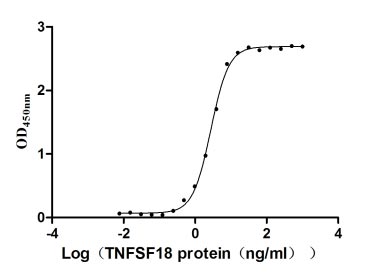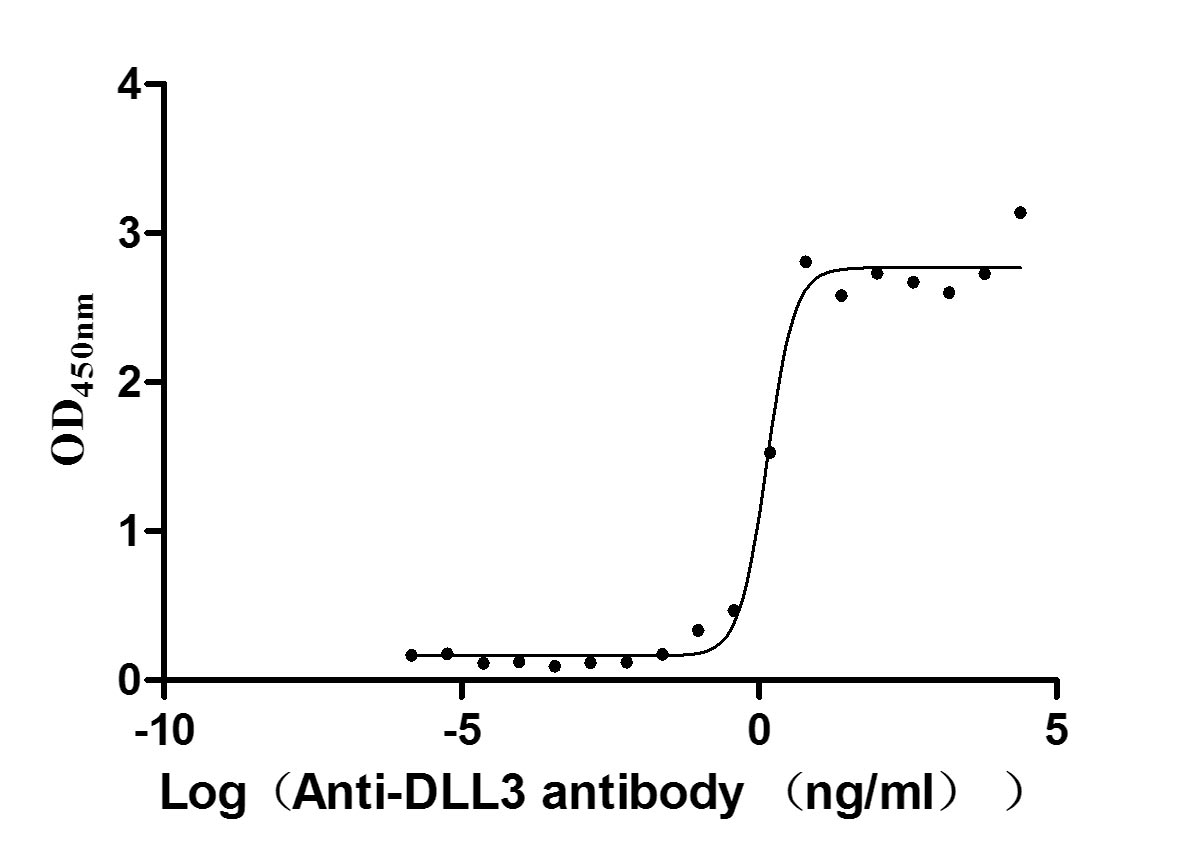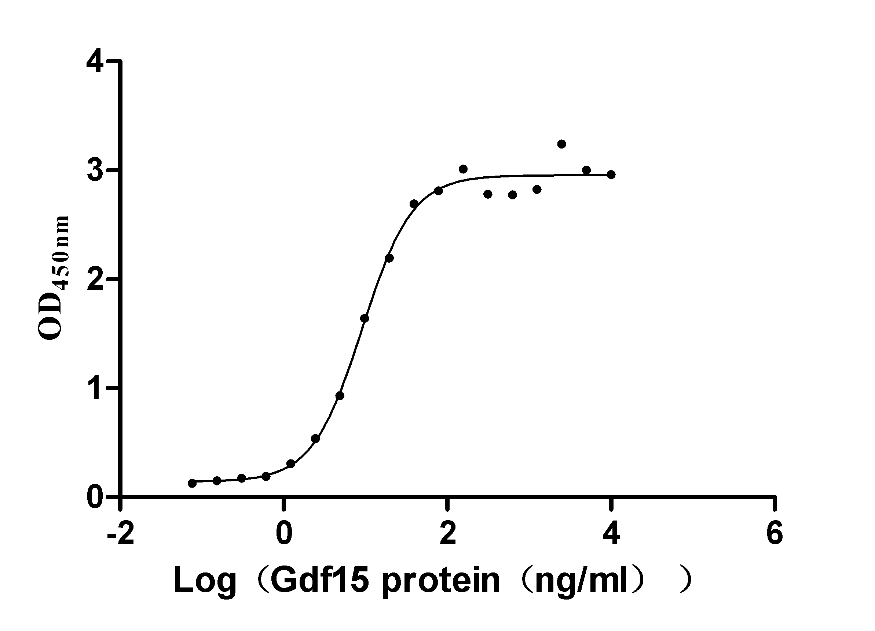Recombinant Human Sphingosine 1-phosphate receptor 1 (S1PR1), partial
-
货号:CSB-YP020650HU1
-
规格:
-
来源:Yeast
-
其他:
-
货号:CSB-EP020650HU1
-
规格:
-
来源:E.coli
-
其他:
-
货号:CSB-EP020650HU1-B
-
规格:
-
来源:E.coli
-
共轭:Avi-tag Biotinylated
E. coli biotin ligase (BirA) is highly specific in covalently attaching biotin to the 15 amino acid AviTag peptide. This recombinant protein was biotinylated in vivo by AviTag-BirA technology, which method is BriA catalyzes amide linkage between the biotin and the specific lysine of the AviTag.
-
其他:
-
货号:CSB-BP020650HU1
-
规格:
-
来源:Baculovirus
-
其他:
-
货号:CSB-MP020650HU1
-
规格:
-
来源:Mammalian cell
-
其他:
产品详情
-
纯度:>85% (SDS-PAGE)
-
基因名:
-
Uniprot No.:
-
别名:S1PR1; CHEDG1; EDG1; Sphingosine 1-phosphate receptor 1; S1P receptor 1; S1P1; Endothelial differentiation G-protein coupled receptor 1; Sphingosine 1-phosphate receptor Edg-1; S1P receptor Edg-1; CD antigen CD363
-
种属:Homo sapiens (Human)
-
蛋白长度:Partial
-
蛋白标签:Tag type will be determined during the manufacturing process.
The tag type will be determined during production process. If you have specified tag type, please tell us and we will develop the specified tag preferentially. -
产品提供形式:Lyophilized powder
Note: We will preferentially ship the format that we have in stock, however, if you have any special requirement for the format, please remark your requirement when placing the order, we will prepare according to your demand. -
复溶:We recommend that this vial be briefly centrifuged prior to opening to bring the contents to the bottom. Please reconstitute protein in deionized sterile water to a concentration of 0.1-1.0 mg/mL.We recommend to add 5-50% of glycerol (final concentration) and aliquot for long-term storage at -20℃/-80℃. Our default final concentration of glycerol is 50%. Customers could use it as reference.
-
储存条件:Store at -20°C/-80°C upon receipt, aliquoting is necessary for mutiple use. Avoid repeated freeze-thaw cycles.
-
保质期:The shelf life is related to many factors, storage state, buffer ingredients, storage temperature and the stability of the protein itself.
Generally, the shelf life of liquid form is 6 months at -20°C/-80°C. The shelf life of lyophilized form is 12 months at -20°C/-80°C. -
货期:Delivery time may differ from different purchasing way or location, please kindly consult your local distributors for specific delivery time.Note: All of our proteins are default shipped with normal blue ice packs, if you request to ship with dry ice, please communicate with us in advance and extra fees will be charged.
-
注意事项:Repeated freezing and thawing is not recommended. Store working aliquots at 4°C for up to one week.
-
Datasheet :Please contact us to get it.
相关产品
靶点详情
-
功能:G-protein coupled receptor for the bioactive lysosphingolipid sphingosine 1-phosphate (S1P) that seems to be coupled to the G(i) subclass of heteromeric G proteins. Signaling leads to the activation of RAC1, SRC, PTK2/FAK1 and MAP kinases. Plays an important role in cell migration, probably via its role in the reorganization of the actin cytoskeleton and the formation of lamellipodia in response to stimuli that increase the activity of the sphingosine kinase SPHK1. Required for normal chemotaxis toward sphingosine 1-phosphate. Required for normal embryonic heart development and normal cardiac morphogenesis. Plays an important role in the regulation of sprouting angiogenesis and vascular maturation. Inhibits sprouting angiogenesis to prevent excessive sprouting during blood vessel development. Required for normal egress of mature T-cells from the thymus into the blood stream and into peripheral lymphoid organs. Plays a role in the migration of osteoclast precursor cells, the regulation of bone mineralization and bone homeostasis. Plays a role in responses to oxidized 1-palmitoyl-2-arachidonoyl-sn-glycero-3-phosphocholine by pulmonary endothelial cells and in the protection against ventilator-induced lung injury.
-
基因功能参考文献:
- Overexpression of S1PR1 promoted subcutaneous xenograft growth and pulmonary metastases and enhanced expression of epithelial-to-mesenchymal transition markers. PMID: 30453284
- Knockdown of BATF3 in HL cell lines revealed that BATF3 contributed to the transcriptional programme of primary HRS cells, including the upregulation of S1PR1. PMID: 28878352
- Data suggest that sphingosine-1-phosphate receptor 1 (S1P1) exhibits a inhibitory effect on kidney ischemia/reperfusion injury-inducedepithelial to mesenchymal transition (EMT) in the kidney by affecting the PI3K/Akt pathway. PMID: 29901713
- Extracellular alpha-synuclein induces sphingosine S1P1R uncoupled from inhibitory G-protein leaving beta-arrestin signal intact. PMID: 28300069
- These results demonstrated that ApoM protein mass were clearly higher in the NSCLC tissues than in non-small cell lung cancer (NSCLC) tissues. Overexpression of ApoM could promote NSCLC cell proliferation and invasion in vitro and tumor growth in vivo, which might be via upregulating S1PR1 and activating the ERK1/2 and PI3K/AKT signaling pathways. PMID: 29750961
- We conclude that S1P attenuates the invasion of C643 cells by activating S1P2 and the Rho-ROCK pathway, by decreasing calpain activity, and by decreasing the expression, secretion and activity of MMP2 and, to a lesser extent, MMP9. Our results thus unveil a novel function for the S1P2 receptor in attenuating thyroid cancer cell invasion. PMID: 29734379
- Elevated S1PR1 expression and STAT3 activation are also observed in human NB cells with acquired resistance to etoposide. We show in vitro and in human NB xenograft models that treatment with FTY720, an FDA-approved drug and antagonist of S1PR1, dramatically sensitizes drug-resistant cells to etoposide. PMID: 28716816
- this review discusses sphingosine-1-phosphate receptor as a novel therapeutic target in ulcerative colitis PMID: 27494562
- Astrocytic S1PR controls astrocyte neurotoxicity and monocyte recruitment and activation. PMID: 28167760
- High S1PR1 expression is associated with anti-neutrophil cytoplasmic antibody-associated vasculitis. PMID: 28206609
- Low S1PR1 expression is associated with Coxsackievirus B3-induced myocarditis. PMID: 28986246
- These findings are consistent with a model in which signalling via S1P and S1PR1 are integral components in the response of lymphatic endothelial cells to the stimulus provided by fluid flow. PMID: 27974574
- S1PR1/3 silencing alters proliferation, adhesion, viability and lateral motility in estrogen receptor-negative MCF-7 and estrogen receptor-positive MDA-MB-231 breast cancer cells. PMID: 28982858
- Activated S1PR1 signaling regulates the production of cellular adhesion molecules by inhibiting NF- kappaB activation via a beta-arrestin2-dependent manner PMID: 28399143
- Model recombinant HDL (rHDL) particles formed in vitro with S1P incorporated into the particle initiated the internalization of S1PR1, whereas rHDL without supplemented S1P did not, suggesting that S1P transported in HDL can selectively activate S1PR1. PMID: 27881715
- Blocking of S1PR activity and inhibition of S1P synthesis led to decreased expression of fibrosis and tissue remodeling-related proteins in primary cultures of orbital fibroblasts derived from patients with GO. PMID: 28492873
- a lipid molecule repeatedly entered the receptor between the extracellular ends of TM1 and TM7, providing important insights into the pathway of ligand entry into the S1PR1 . PMID: 28370663
- Mature human thymocytes rely on S1P-R1 to migrate toward S1P. Taken in the context of murine work demonstrating that S1P is required for thymocyte egress to the periphery. PMID: 27056271
- ApoM-bound sphingosine-1-phosphate regulates adhesion molecule abundance, leukocyte-endothelial adhesion, and endothelial barrier function via sphingosine-1-phosphate receptor1. PMID: 27879252
- The S1P1,3 activation results in Akt phosphorylation and subsequent activation of eNOS via phosphorylation at serine(1177) and dephosphorylation at threonine(495). PMID: 27282481
- HDL-associated ApoM is anti-apoptotic by delivering sphingosine 1-phosphate to S1P1 and S1P3 receptors on vascular endothelium. PMID: 28179022
- The present high prevalence of S1PR1 overexpression warrants the consideration of testicular diffuse large B-cell lymphoma as a distinct disease subtype and suggests the potential of the S1P/S1PR1 axis as a therapeutic target. PMID: 27061580
- S1PR1 inhibits the apoptosis of human myeloid leukemia cells and promotes their proliferation. PMID: 27572094
- These results suggest that S1P signaling plays a role in cell proliferation and drug resistance in multiple myeloma, and targeting this pathway will provide a new therapeutic direction for multiple myelomamanagement. PMID: 27785703
- Sphingosine 1-phosphate-induced IL-8 gene expression is mainly regulated via S1PR(1), and its secretion is regulated through S1PR(2) receptor subtype. PMID: 26321412
- multiple lines of evidence demonstrate that S1PR1 signaling sets the sensitivity of pDC amplification of IFN responses, thereby blunting pathogenic immune responses PMID: 26787880
- The results indicate that sphingosine 1-phosphate is involved in the migration of precursor T-cell lymphoblastic leukemia-lymphoma blasts in vitro, which is dependent on S1P1 expression. PMID: 26824863
- Overexpression of miR148a or inhibition of S1PR1 suppressed SKOV3 cell migration and invasion, while restoration of S1PR1 expression reversed the suppressive effect of miR148a upregulation on SKOV3 cell migration and invasion. PMID: 26004261
- the ability of ApoM(+)HDL to act as a biased agonist on S1P1 inhibits vascular inflammation, which may partially explain the cardiovascular protective functions of HDL. PMID: 26268607
- S1P receptor modulation reduces leukocyte migration across the endothelial barrier PMID: 26197437
- SGPL1 ratio correlated with increased cellular sphingosine-1-phosphate (S1P), and S1P correlated with drug resistance (IC50). PMID: 26493335
- The role of sphingosine-1-phosphate in the production of immature double-negative thymocytes in experimental and chronic Chagas disease is reported. PMID: 25330249
- Within lymphoid follicles, the S1P1 distribution pattern is complementary to that of CCR7/CXCR4, with strong immunoreactivity tightly restricted to mantle zone B cells. This may play a role in B-cell migration toward the S1p-enriched follicle center. PMID: 26282174
- Ponesimod, a selective S1P1 receptor modulator, causes small, dose-dependent QT prolongation. PMID: 25287214
- rapid reduction of endothelial cell surface expression of S1PR1 subsequent to Y143 phosphorylation is a crucial mechanism of modulating S1PR1 signaling, and hence the endothelial barrier repair function of S1P. PMID: 25588843
- Sphingosine-1-phosphate promotes extravillous trophoblast cell invasion by activating MEK/ERK/MMP-2 signaling pathways via S1P/S1PR1 axis activation. PMID: 25188412
- both S1PR1 and S1PR2 play a pivotal role in hyperglycemia-induced EC dysfunction and endothelial injury by reducing and enhancing the production of oxidative stress. PMID: 25673082
- S1PR1 expression was associated with unfavourable clinicopathological features and the expression of several anti-apoptosis/proliferation-related markers in urothelial carcinoma. PMID: 26238015
- Data suggest an SNP in S1PR1 (rs41287280) is associated with protection against coronary artery disease; some SNPs in S1PR1 have the effect that endocytosis is resistant to S1PR1 antagonists (fingolimod) or S1PR1 agonists (sphingosine 1-phosphate). PMID: 25293589
- Activation of the S1PR1-PLC-IP3 R-Ca(2+) -Rac1 pathway governs the low-dose S1P-enhanced endothelial barrier integrity. PMID: 25557733
- S1P interacts with its receptors on neutrophils, resulting in NADPH oxidase activation by the PI3K-Akt cell signaling pathway and induction of the neutrophil respiratory burst. PMID: 25872153
- S1P1 is widely expressed across tissues and, when activated, has broad functions in the immune, vascular and nervous systems. [Review] PMID: 25498971
- Our data demonstrate that neuronal cell death evoked by ceramide is regulated by PARP/PAR/AIF and by S1P receptor signalling. PMID: 24420784
- Expression of functional S1PR1 is reduced by B cell receptor signaling and increased by inhibition of PIK3CD but not SYK or BTK in chronic lymphocytic leukemia cells. PMID: 25632006
- The data demonstrates that S1P1 expression is differentially modulated in grey matter and white matter lesions in multiple sclerosis. PMID: 23551178
- S1PR1 was a target of miR-125b-1-3p in the placenta. Overexpression of S1PR1 could reverse the inhibitory effect of miR-125b-1-3p on the invasion of trophoblast cells. Abnormal expression of miR-125b-1-3p might contribute to the etiology of preeclampsia. PMID: 25251470
- Study demonstrates a stark contrast between the consequences of S1PR1 signaling in Treg cells in the periphery versus tumors. PMID: 24630990
- Aberrant S1PR1 expression in colorectal cancer was associated with metachronous liver metastasis and worse survival outcome PMID: 24972972
- Data show that sphingosine kinase SphK1 and sphingosine-1-phosphate (S1P) receptors S1P1, S1P2, S1P3, and S1P5 were expressed from primary, up to recurrent and secondary glioblastomas, with sphingosine kinase SphK2 levels were highest in primary tumors. PMID: 24903384
- study demonstrates loss of S1P and sphingosine kinase activity early in AD pathogenesis, and prior to AD diagnosis. Our findings establish a rationale for further exploring S1P receptor pharmacology in the context of AD therapy. PMID: 24456642
显示更多
收起更多
-
亚细胞定位:Cell membrane; Multi-pass membrane protein. Endosome. Membrane raft. Note=Recruited to caveolin-enriched plasma membrane microdomains in response to oxidized 1-palmitoyl-2-arachidonoyl-sn-glycero-3-phosphocholine. Ligand binding leads to receptor internalization.
-
蛋白家族:G-protein coupled receptor 1 family
-
组织特异性:Endothelial cells, and to a lesser extent, in vascular smooth muscle cells, fibroblasts, melanocytes, and cells of epithelioid origin.
-
数据库链接:
HGNC: 3165
OMIM: 601974
KEGG: hsa:1901
STRING: 9606.ENSP00000305416
UniGene: Hs.154210
Most popular with customers
-
Recombinant Human Tumor necrosis factor ligand superfamily member 18 (TNFSF18), partial (Active)
Express system: Mammalian cell
Species: Homo sapiens (Human)
-
Recombinant Human Delta-like protein 3 (DLL3), partial (Active)
Express system: Mammalian cell
Species: Homo sapiens (Human)
-
Recombinant Mouse GDNF family receptor alpha-like (Gfral), partial (Active)
Express system: Mammalian cell
Species: Mus musculus (Mouse)
-
Recombinant Human C5a anaphylatoxin chemotactic receptor 1 (C5AR1)-VLPs (Active)
Express system: Mammalian cell
Species: Homo sapiens (Human)
-
Recombinant Human G-protein coupled receptor family C group 5 member D (GPRC5D)-VLPs (Active)
Express system: Mammalian cell
Species: Homo sapiens (Human)
-
Recombinant Macaca fascicularis Trophoblast glycoprotein (TPBG), partial (Active)
Express system: Mammalian cell
Species: Macaca fascicularis (Crab-eating macaque) (Cynomolgus monkey)
-
Recombinant Human Claudin-6 (CLDN6)-VLPs, Fluorescent (Active)
Express system: Mammalian cell
Species: Homo sapiens (Human)
-
Recombinant Human Desmoglein-2 (DSG2), partial (Active)
Express system: Mammalian cell
Species: Homo sapiens (Human)








f4-AC1.jpg)











